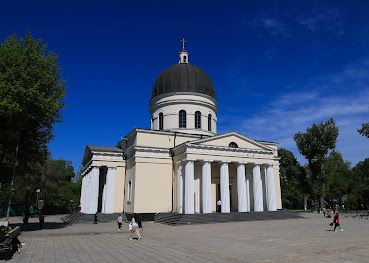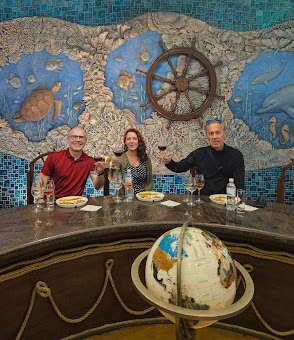Moldova
Chisinau and Surroundings
April 29th - May 1st, 2024
This is my trip report about a very short trip to the country of Moldova. Moldova is a small landlocked country with a population of less than 3 million people, that is wedged between Ukraine to the east and Romania to the west. I arrived on a direct flight from Vienna, and met up with my friend Mark in Chisinau. Chisinau is the largest city and the capital of the country (and, as I learned here, it is pronounced "Kishinow", and not "Cheesynow").
Chisinau is a very pleasant, clean and surprisingly wealthy city. It is not a particularly historic city, as most of the buildings are from the 19th and 20th century. We started our sightseeing at the Stefan cel Mare Central Park, which is a beautiful and tranquil city park and it is where most of the cities monuments and historical landmarks are located. The neoclassical Nativity Cathedral, built in the 1830s, marks the center of the city.
The cathedral's bell tower, which is not attached to the main building, was rebuilt in 1997 after the previous one was destroyed by the local communists in 1962.
Other sights in the park include the statue of Stephen the Great, who is Moldova's national hero for defending the country against the Ottomans, and the elegant Chisinau Water Tower. Built at the end of the 19th century, the tower was an important part of the city's water system.
The Moldovian Triumphal Arch was built in 1840 to celebrate a victory of the Russian Empire over the Ottomans.
Moldova has been an independent country only since 1991. Previously part of the Russian Empire, the region, then known as Bessarabia, united with Romania after WWI. It was annexed by the Soviet Union in 1940, and for the next 50 years became the Moldavian Soviet Socialist Republic. After declaring independence in 1991, tensions with the Russian-speaking region of Transnistria led to a short war in 1992. Transnistria, which occupies the small strip of land between the Dniester river and the Ukrainian border in the east, is controlled and supported by Russia, but not recognized by any other country. This situation has remained largely unchanged since the war, which ended in an uneasy ceasefire without a peace settlement. It is possible to visit Transnistria on a day trip from Chisinau, but given the security concerns due to the Ukraine war, we had decided against doing that.
Instead, on our second day, we took a trip from Chisinau to the countryside in the north of the city. We had a full-day tour booked on Viator, and we were joined by Ines, a solo traveler from Uruguay. The tour started at the beautiful Curchi Monastery, located about 30 minutes to the north of the city.
Curchi Monastery is the most significant monastery in the country and symbol of Moldova’s religious and cultural revival. It was founded in 1773 and over the years it was expanded into a large religious complex, surrounded by gardens, lakes and forests. During Soviet rule Curchi Monastery was closed as a religious institution and the buildings were repurposed for various other uses, including a psychiatric hospital. After the fall of the Soviet Union, Moldova's Orthodox Church began extensive restorations, which were completed in 2006, to return the complex to its former glory.
The Church of the Nativity of the Virgin Mary, the larger and older of the two churches, was constructed between 1808 and 1810 in Baroque style. The interior is covered in these stunning frescoes and intricate gold decorations.
Our next stop was Old Orhei, which is an important archeological site located in a valley formed by a narrow bend of the Raut River about 60 km northeast of Chisinau. Evidence of human settlement in this valley goes back to the 6th century BCE. Old Orhei gained particular prominence during 10th to 14th centuries, when it was a fortified city, although not much evidence remains of it. The area was conquered and occupied by the Mongol Golden Horde in the 13th century.
In the late 14th century the Christianization of the region began and several Orthodox churches and monasteries were established here. The most notable being the Cave Monastery, which is carved into the cliffs above the river. This monastery became an important place of worship and pilgrimage. It still functions today and is maintained by a handful of monks living here.
From the other side of the river we had this beautiful view of the small orthodox church sitting on top of the cliffs.
Our last stop on the tour was the Cricova winery. Moldova has a history of wine making going back 5000 years. Today wine is one of the main export products of the country. Cricova has a wine cellar consisting of 120 km of underground tunnels, which we traversed in a small train. Their main product is sparkling wine, using the French champagne method of fermentation in the bottle. There are 2 million bottles in this cellar and every bottle has to be turned by hand every couple of days, which is done by only 6 women.
We visited the museum and the enormous storage area, where many private collectors store their wine collections in ideal conditions. We ended the trip with a lovely wine tasting inside the caves.
Two days was certainly not enough to see everything Moldova has to offer, but it was enough to get a good first impression of the country. We left on a very early morning flight to Bucharest the next day.





















No comments:
Post a Comment